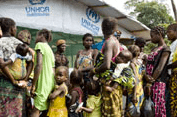Last December, when refugees started pouring into Liberia from the Ivory Coast, the government and international officials in Monrovia grew increasingly alarmed. This post-conflict country, one of the world’s poorest by almost any measure, was already struggling to provide for border communities, where most families enjoyed just one meal a day. With each of the 150,000 Ivorian refugees who trickled and then flooded in, the strain grew. To this day, UNICEF reports a steady stream of new arrivals from the Ivory Coast.
It’s hard to understate how rough this has been for Liberia. There are some 215 Liberian villages that are currently hosting refugees, often without the means to do so. In the first weeks of the conflict, local families fed the displaced with their own resources and food stocks. Now, the U.N. High Commission for Refugees is providing assistance to both the refugee and local populations. But it’s indicative of just what a stress this refugee influx is that almost five times as many Liberians are malnourished as Ivorian refugees.
Now it’s crunch time to make sure that the difficult situation doesn’t get any harder. It’s rainy season in West Africa, which means that roads are increasingly difficult to access. Food, medical, and other daily supplies arrive more slowly and they’re distributed with even more difficulty. Inconveniently, as the logistics get more complicated, the needs also grow. As a July 8 situation report from UNICEF explains, “Continuous rain is also increasing the need for clothes, blankets and mosquito nets which are required urgently for immediate distribution to children and women.”
Of particular concern is the health situation, which always gets more complicated when the rains start. Mosquitos love a good, humid shower, raising the incidence of malaria across communities. The U.N. worries, “There is a high risk of water-borne and sanitation related diseases and epidemics.” In a country with no water system in the capital — let alone in the rural areas — diseases like cholera and typhoid spread like wildfire.
The good news is that now half a year into this crisis, humanitarian groups are highly mobilized to make sure that refugee and local needs are cared for. But all the often, there’s just too much need and not enough to go around. This operation has had a problem of underfunding since it began months ago. Today, the operation has about $10 million of the $18.9 million it needs.
As I’ve written here before, the short conflict in the Ivory Coast took an outsized toll. Compared to the just four months that the political stand-off lasted, the societal implications were massive, and they’ll long outlast the immediate political strains. And that’s not just true in the Ivory Coast. Along the Liberian border, there are long months ahead before this crisis truly is over.
